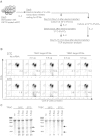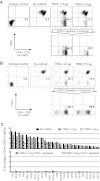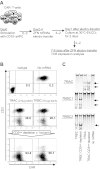A foundation for universal T-cell based immunotherapy: T cells engineered to express a CD19-specific chimeric-antigen-receptor and eliminate expression of endogenous TCR
- PMID: 22535661
- PMCID: PMC3382929
- DOI: 10.1182/blood-2012-01-405365
A foundation for universal T-cell based immunotherapy: T cells engineered to express a CD19-specific chimeric-antigen-receptor and eliminate expression of endogenous TCR
Erratum in
- Blood. 2015 Nov 26;126(22):2527. Rabinovitch, Brian [corrected to Rabinovich, Brian]
Abstract
Clinical-grade T cells are genetically modified ex vivo to express a chimeric antigen receptor (CAR) to redirect specificity to a tumor associated antigen (TAA) thereby conferring antitumor activity in vivo. T cells expressing a CD19-specific CAR recognize B-cell malignancies in multiple recipients independent of major histocompatibility complex (MHC) because the specificity domains are cloned from the variable chains of a CD19 monoclonal antibody. We now report a major step toward eliminating the need to generate patient-specific T cells by generating universal allogeneic TAA-specific T cells from one donor that might be administered to multiple recipients. This was achieved by genetically editing CD19-specific CAR(+) T cells to eliminate expression of the endogenous αβ T-cell receptor (TCR) to prevent a graft-versus-host response without compromising CAR-dependent effector functions. Genetically modified T cells were generated using the Sleeping Beauty system to stably introduce the CD19-specific CAR with subsequent permanent deletion of α or β TCR chains with designer zinc finger nucleases. We show that these engineered T cells display the expected property of having redirected specificity for CD19 without responding to TCR stimulation. CAR(+)TCR(neg) T cells of this type may potentially have efficacy as an off-the-shelf therapy for investigational treatment of B-lineage malignancies.
Figures






References
-
- Cooper LJ, Al-Kadhimi Z, DiGiusto D, et al. Development and application of CD19-specific T cells for adoptive immunotherapy of B cell malignancies. Blood Cells Mol Dis. 2004;33(1):83–89. - PubMed
Publication types
MeSH terms
Substances
Grants and funding
LinkOut - more resources
Full Text Sources
Other Literature Sources
Research Materials

